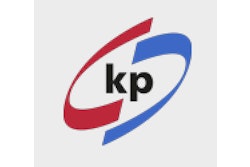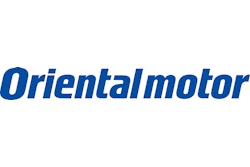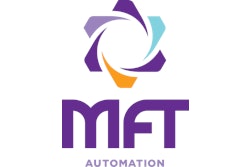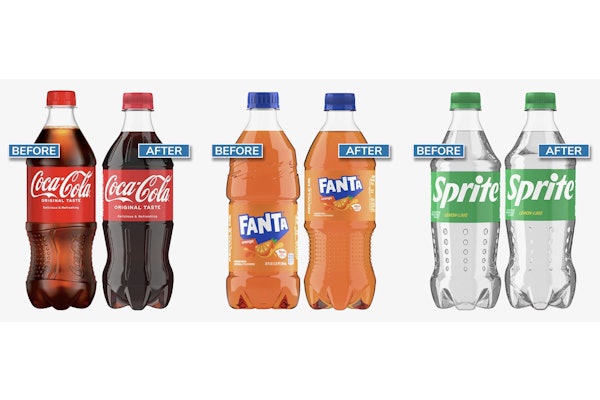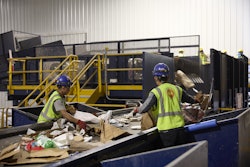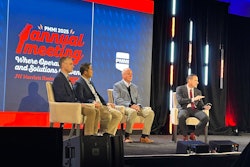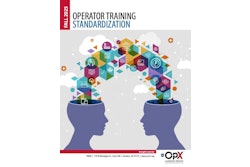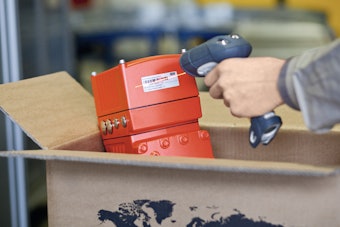Readers of this magazine will probably recognize the NanoFil package as an example of the Natralock concept from MWV. Natralock is positioned as a more sustainable alternative to the traditional clamshell because it greatly reduces the amount of plastic involved and replaces it with paperboard instead.
Like other packages in the Natralock family, this one comprises a clear thermoformed blister and 18-pt SBS that is run through a patented extrusion-coating process that applies a heat-seal material. The paperboard is scored in the middle. Once the blister is placed into the round die-cut hole and the spool of fishing line is placed in the blister, the paperboard is folded and one half is heat sealed to the other. This traps the flange of the blister firmly in between the two paperboard halves. Because the blister is merely trapped rather than glued to the paperboard, it separates easily and thoroughly from the paperboard, thus making it easy for consumers to put the board in its recycle stream and the blister in a separate recycle stream. The Natralock package is also easier for consumers to open because a simple scissors does the trick-not the case in the traditional clamshell package.
While the features detailed above are what make the NanoFil package similar to other Natralock executions, this is where the similarities end. This is the first Natralock package with a twist-off blister, a feature that was required because fishermen who buy this product typically use it to replenish the line on more than one fishing reel. That being the case, they need a container to which they can return the spool in between uses. The twist-off blister also twists back onto the paperboard portion of the Natralock package, so it’s a format that provides consumers with the container they need to store the product between uses.
So why did Pure Fishing take such a novel approach to packaging? Todd Backhaus, Pure Fishing’s senior manufacturing engineer, puts it this way: “If we were coming out with a revolutionary line, we didn’t want to put it in a conventional tuck carton. We wanted our packaging to be as revolutionary as the line itself.” He hastens to add that the cost of the innovative package is about the same as some of the other high-end, embossed folding cartons used elsewhere in Pure Fishing’s product line.
No slam dunk
While MWV played a central role in bringing the NanoFil package to the marketplace, three other vendors were also essential: Starview Packaging Machinery, Inc., Multifeeder, and thermoformer Package Development Co. Inc.. Starview provides the Model FAB8-1418 Eight-Station automatic blister packaging machine with card-transfer mechanism, automatic card fold-over, package sealing, and finished-package unloading. Multifeeder provided the Model MFT IP 350XED industrial performance friction feeder that feeds the fold-over cards from a vertical stack and into a catch tray just ahead of the Starview machine.
Some of the heaviest lifting on this packaging innovation was done by Package Development Co., Inc., the firm that thermoforms the clear blister from Post-Consumer Recycled PET supplied by Klöckner Pentaplast. To best understand how challenging it was to make this part, it helps to review how the finished package operates in the consumer’s hands (refer to Figure A):
• Twist blister counterclockwise to break the sealed tab.
• Continue twisting counterclockwise until a specially formed dome on the flange of the blister pops up through a die cut (see Figure B) in the paperboard positioned at 3 o’clock.
• Continue twisting the blister until it comes completely free of the paperboard.
• Pull spool from blister; after removing the desired amount of fishing line, snap spool back into blister.
• Return blister to paperboard by first inserting arrow-marked portion of blister flange into the 3 o’clock die cut in the paperboard and then twisting clockwise.
All of the above functionality was cleverly conceptualized by MWV and Pure Fishing. But none of it could have been commercialized if not for some precision thermoforming on the part of Package Development. Take, for example, the eight denesting spacing lugs (see Figure A) molded into the sidewalls of the blister. Without these, denesting of the blisters and placement into the stations of the Starview blister packaging machine could not have been automated. These spacing lugs serve a dual function. They also keep the spool of fishing line from rotating inside the clear blister, thus ensuring that the graphics on the spool remain properly oriented at the all-important moment when the consumer encounters the package in the retail store.
The breakable tab (see Figure A) is another crucial thermoforming detail. When the two halves of the fold-over paperboard are glued to each other, this breakable tab is permanently glued to the paperboard at the 5 o’clock position. Why? So that the round blister won’t rotate. If it did, the Berkley NanoFil brand would not be oriented consistently and might even be upside down. Package Development perforates the tab at the point where it meets the flange. So when the consumer gives the blister a counterclockwise twist, the blister breaks free from the tab at the perforation line. This lets the consumer twist the blister out from the paperboard. The tab stays attached to the paperboard.
A third thermoforming feature molded into the sidewall of the blister is what Package Development calls an anti-rotation boss (see Figure A). There are four of these, and they contribute by keeping the thermoformed blisters from rotating as they come out of the forming mold and are stacked. These anti-rotation bosses also ensure that the blisters are in the correct orientation when the Starview blister pack machine picks them out of a stack and places them in its rotary turntable.
One final bit of thermoforming magic is the dome on the flange of the blister. The tooling used to thermoform the blister combined with the way in which the finished piece is cut from its matrix gives memory to this little piece of plastic. It’s this memory that causes the dome to pop out through the 3 o’clock die cut in the paperboard, thus making it possible to unscrew the blister from the paperboard.
In-plant operation
All this attention to detail at the thermoforming end pays big dividends when it comes time to automatically place spools of freshly made fishing line into blister packs. The process begins with the Multifeeder machine picking a single fold-over Natralock card and placing it in the catch tray of a device built in-house by Pure Fishing. This device also unwinds a 4” length of fishing line, cuts it, and tamps it onto the Natralock card (see sidebar, p. 39).
Next the fold-over card is picked by the Starview machine and placed in one of the eight sealing fixtures on the Starview’s rotary table. The table indexes one position and a blister is automatically denested into the sealing fixture. A spool of line is inserted next—again, it’s done automatically by a servo-driven system designed in-house by Pure Fishing. Servo and stepper motors from Oriental Motor, armed with information they receive from a vision system, help spin the spool so that it enters the thermoform with the label squarely facing forward. One other modification that Pure Fishing needed to make on the Starview machine was required because the spool of line must be “snapped” into the spacing lugs rather than being merely “placed.”
In the next station the fold-over card is folded and heat-sealed. All that’s left is manual application of a UPC label and loading into a four-pack carton for shipment to the retail channel.
Backhaus appreciates the way that material and machinery suppliers were all on the same page as the project unfolded.
“MWV had a prior awareness of Starview equipment and recommended them for this project,” says Backhaus. “As we looked at our machinery supplier options, we liked the turnkey solution that using Starview offered. It was a matter of the equipment maker being able to work with the materials suppliers and vice versa.”
Package Development’s Charles Schwester also has high praise for the Starview equipment. “They did an excellent job. Their equipment—aided by the thermoforming details we provided—picks up our blister and keeps perfect control of it so that the locking tab is always positioned right where it needs to be: at 5 o’clock. Their machine design and execution were flawless.”
Such mutual admiration among the suppliers behind the project would be of little value, of course, if retailers and consumers weren’t equally enthusiastic. But they are, says Berkley senior product manager Clay Norris.
“This package really stands out compared to the conventional folding carton usually used for this product category,” says Norris. “It’s noticeably different, and the feedback we’ve gotten from both retailers and consumers has been very positive.”



